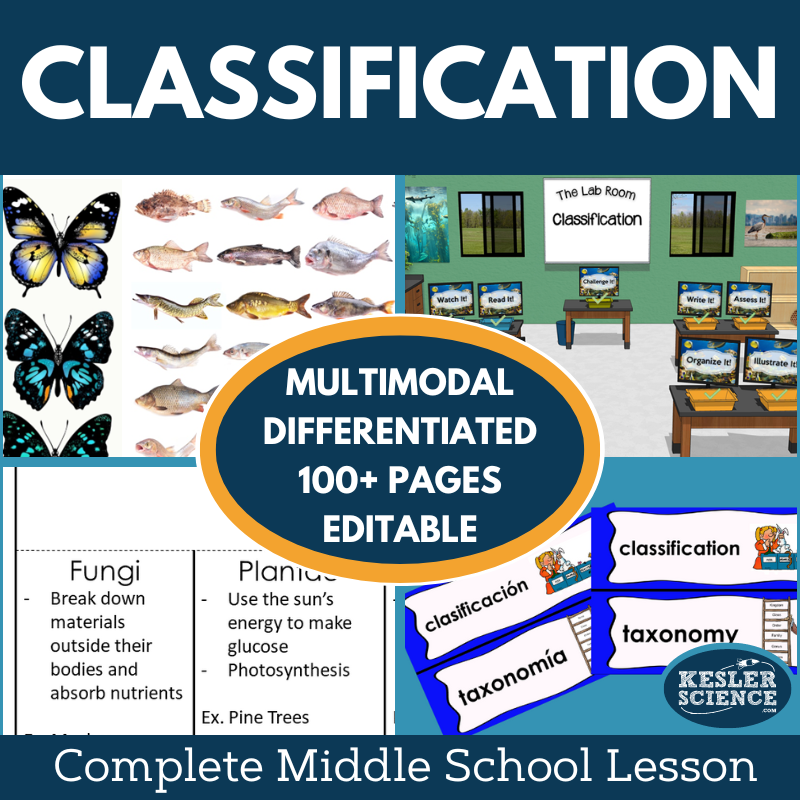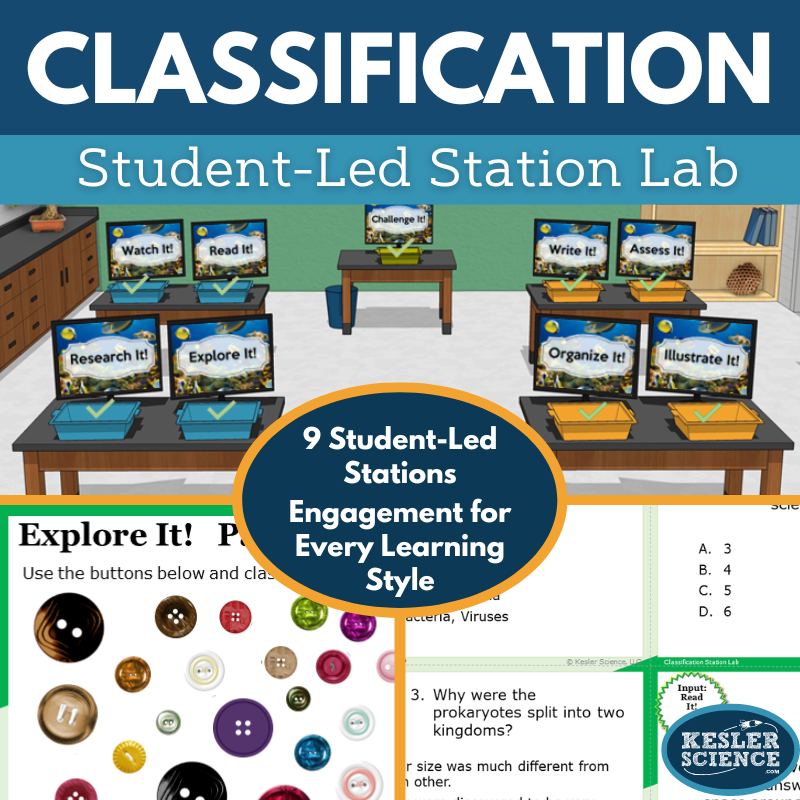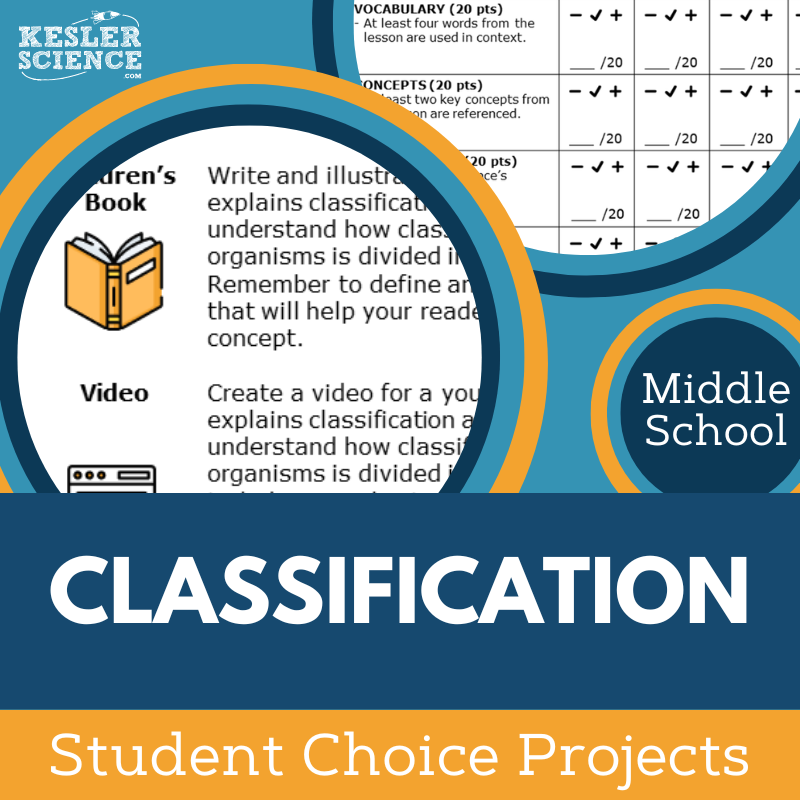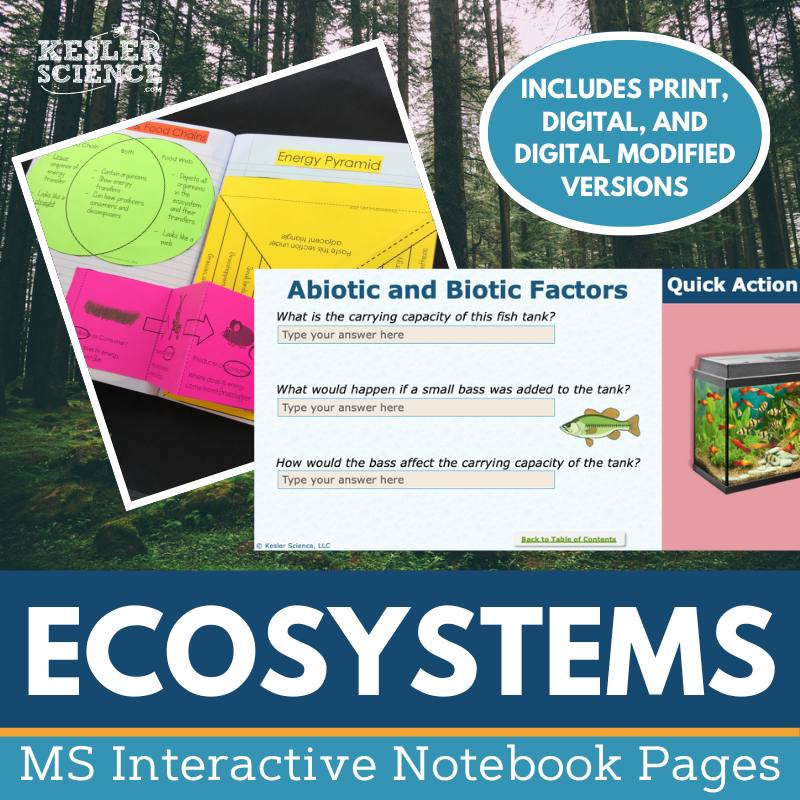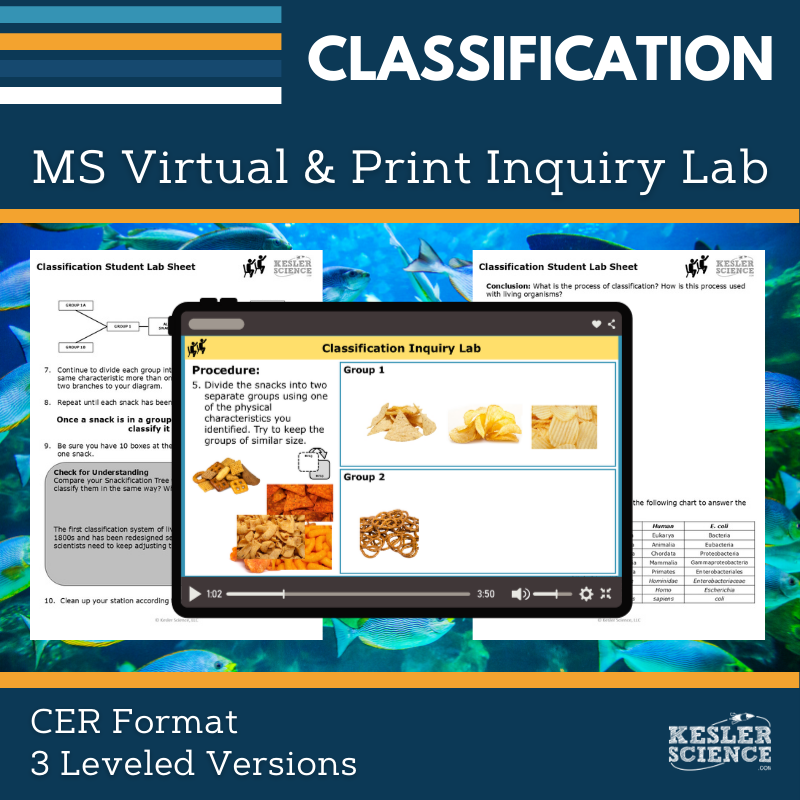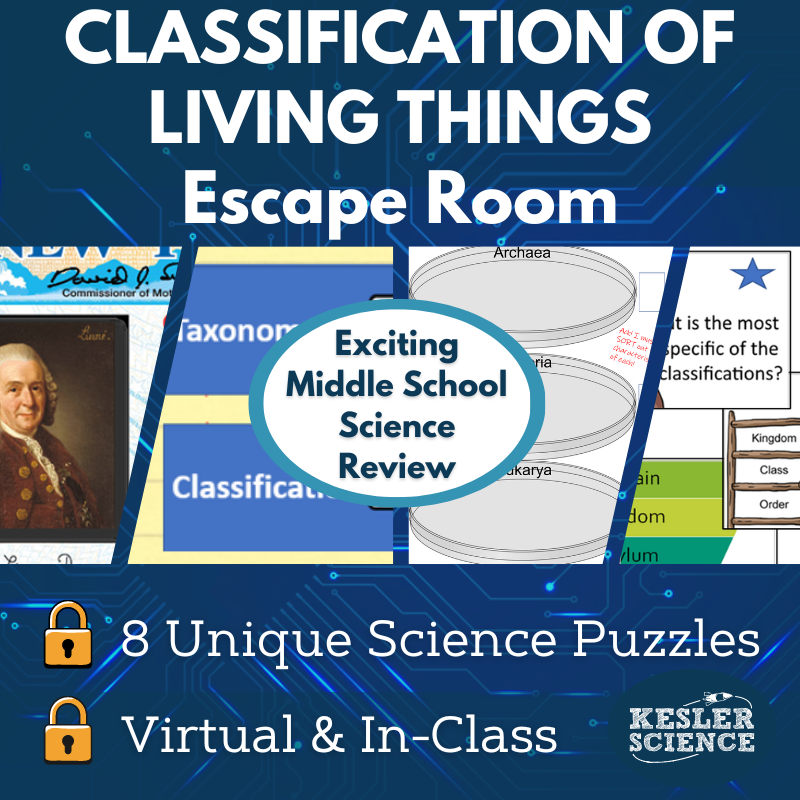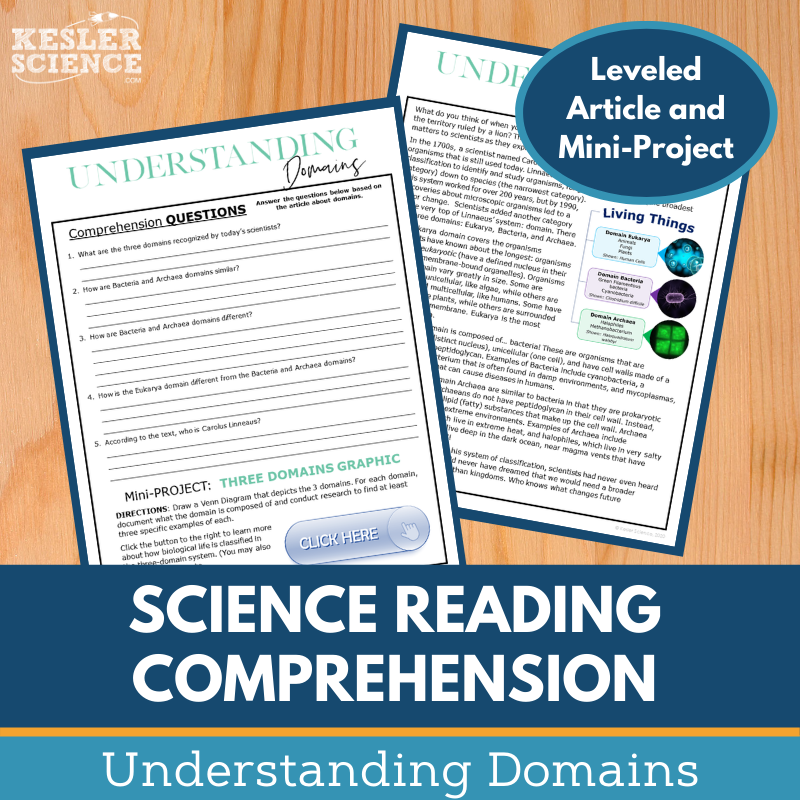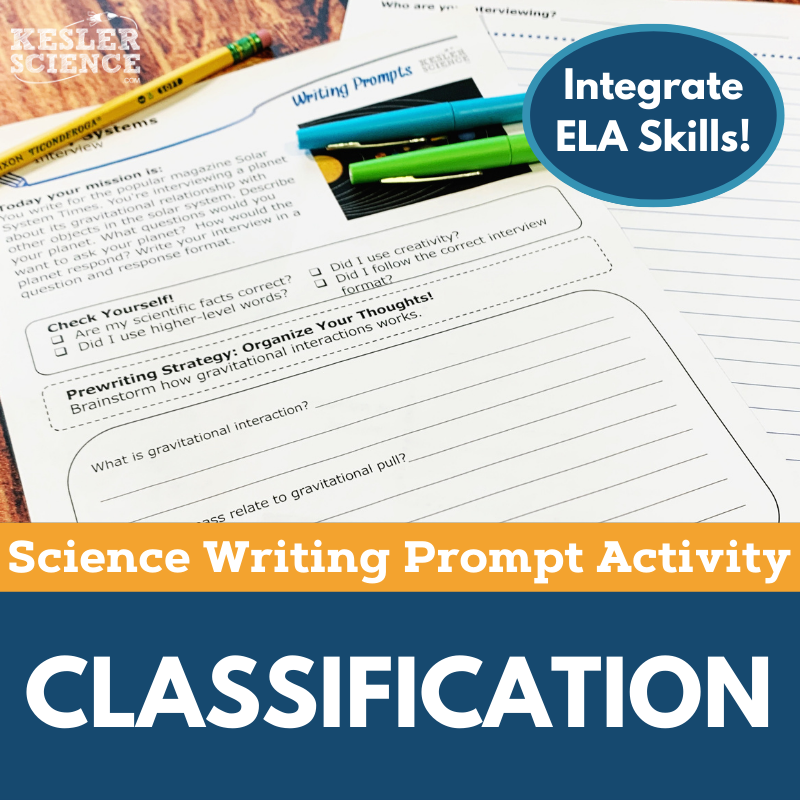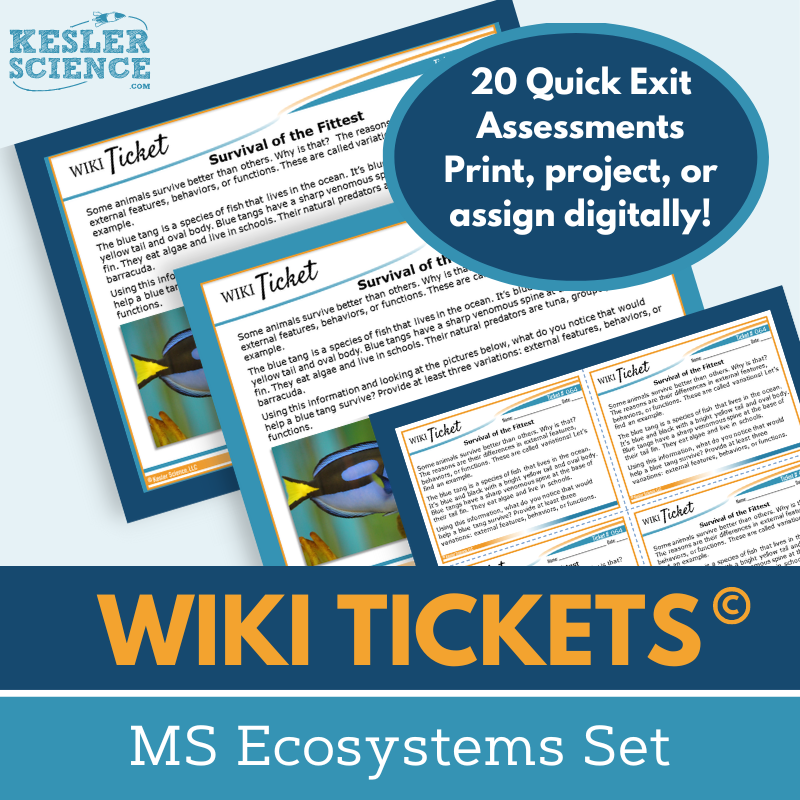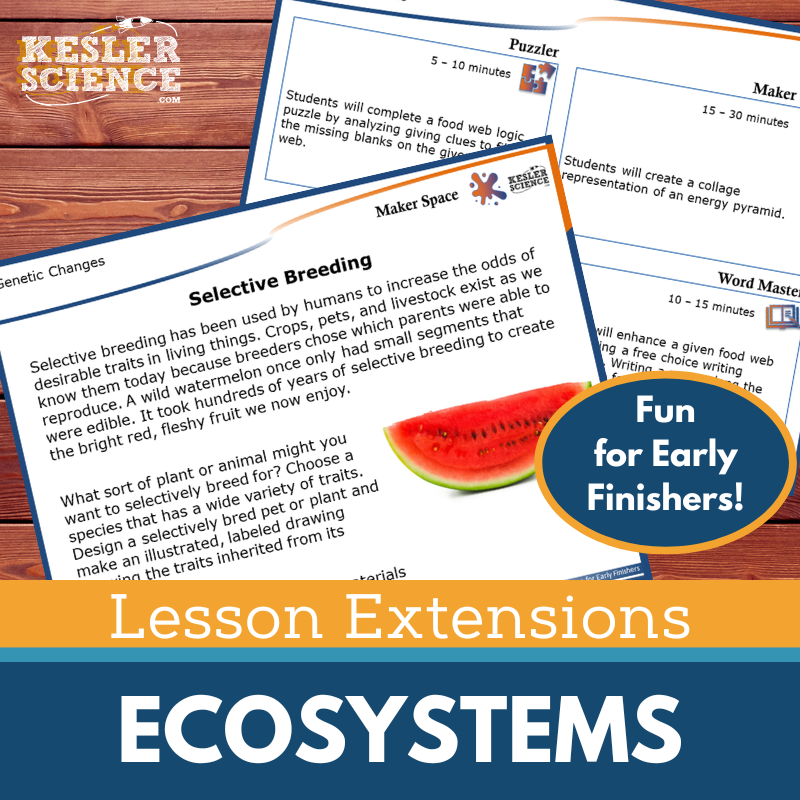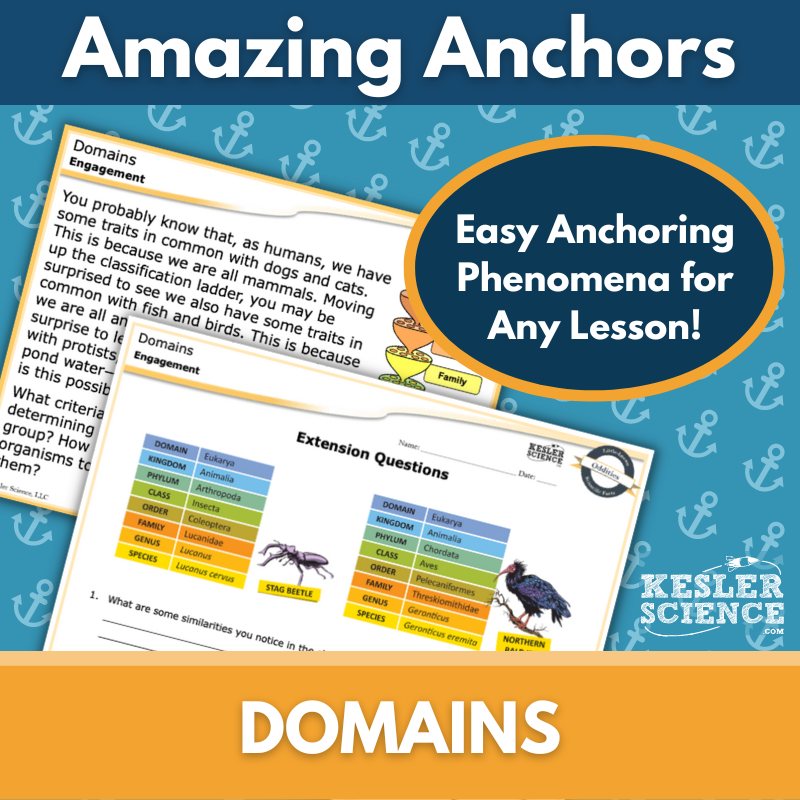Classification Activities for Middle School Science
Kesler Science Classification resources provide a comprehensive, student-led approach for teaching the classification of living organisms. The resources below will give students a comprehensive understanding of classification. All of the following materials are also included in the Kesler Science Membership.
The Kesler Science Classification Complete Lesson is designed for middle school students to explore the classification of living organisms using a student-led, 5E approach. With minimal prep and comprehensive materials, this lesson encourages inquiry and critical thinking while addressing the essential question: "How is the broadest taxonomic classification of living organisms divided into currently recognized Domains?" It includes differentiated resources and flexibility in both printable and digital formats, ensuring accessibility for all learners.
The lesson incorporates nine station activities across the Exploration phase, allowing students to engage with classification concepts through hands-on demonstrations, research tasks, reading passages, and videos. Output stations like "Organize It!" and "Illustrate It!" help students demonstrate their understanding through creative and written responses, while the bonus "Challenge It!" station provides additional enrichment for early finishers.
For the Explanation and Elaboration stages, the lesson includes editable PowerPoints, interactive notebooks (available in both digital and print formats), and student-choice projects to deepen learning. The Evaluation phase offers standards-aligned assessments with multiple versions for differentiation. This resource is ideal for both in-person and virtual learning environments, making it flexible for any classroom setup.
The Kesler Science Classification Complete Lesson is designed for middle school students to explore the classification of living organisms using a student-led, 5E approach. With minimal prep and comprehensive materials, this lesson encourages inquiry and critical thinking while addressing the essential question: "How is the broadest taxonomic classification of living organisms divided into currently recognized Domains?" It includes differentiated resources and flexibility in both printable and digital formats, ensuring accessibility for all learners.
The lesson incorporates nine station activities across the Exploration phase, allowing students to engage with classification concepts through hands-on demonstrations, research tasks, reading passages, and videos. Output stations like "Organize It!" and "Illustrate It!" help students demonstrate their understanding through creative and written responses, while the bonus "Challenge It!" station provides additional enrichment for early finishers.
For the Explanation and Elaboration stages, the lesson includes editable PowerPoints, interactive notebooks (available in both digital and print formats), and student-choice projects to deepen learning. The Evaluation phase offers standards-aligned assessments with multiple versions for differentiation. This resource is ideal for both in-person and virtual learning environments, making it flexible for any classroom setup.
The Kesler Science Classification Station Lab offers a modular, student-led approach to learning about classification, perfect for middle school students. With eight differentiated activities, this lab gives students the chance to explore key concepts about Bacteria, Archaea, and Eukarya through engaging, hands-on tasks. Teachers can focus on facilitating learning while students work independently or in small groups, making this resource both efficient and effective.
The nine stations include a variety of input and output activities, such as "Explore It!" where students apply their learning through demonstrations, "Read It!" with differentiated reading passages in English and Spanish, and "Watch It!" with a video and questions. Output activities like "Organize It!" and "Illustrate It!" allow students to show what they’ve learned through hands-on tasks, visual models, and written responses.
This flexible, student-centered lab is designed for both in-person and virtual learning environments, with materials like task cards, literature, and resources provided. The bonus "Challenge It!" station provides additional activities for early finishers, further enriching the learning experience.
The Kesler Science Classification Station Lab offers a modular, student-led approach to learning about classification, perfect for middle school students. With eight differentiated activities, this lab gives students the chance to explore key concepts about Bacteria, Archaea, and Eukarya through engaging, hands-on tasks. Teachers can focus on facilitating learning while students work independently or in small groups, making this resource both efficient and effective.
The nine stations include a variety of input and output activities, such as "Explore It!" where students apply their learning through demonstrations, "Read It!" with differentiated reading passages in English and Spanish, and "Watch It!" with a video and questions. Output activities like "Organize It!" and "Illustrate It!" allow students to show what they’ve learned through hands-on tasks, visual models, and written responses.
This flexible, student-centered lab is designed for both in-person and virtual learning environments, with materials like task cards, literature, and resources provided. The bonus "Challenge It!" station provides additional activities for early finishers, further enriching the learning experience.
The Kesler Science Classification Student Choice Projects allow middle school students to select a project that suits their learning style. With six project options and a "design your own" choice, students can create personalized projects to demonstrate their understanding of classification. The flexible grading rubric allows teachers, peers, or students to assess their work, making it adaptable to different classroom needs.
The project includes nine choice board options and a "design your own" option, with teacher directions and an editable rubric that evaluates vocabulary, concepts, presentation, clarity, and accuracy. These projects are differentiated for students at varying levels, with modifications to support learners needing additional help and challenges for advanced students.
Materials needed are basic classroom supplies such as paper, markers, and scissors, with many projects being digital-friendly. This versatility allows students to express their learning creatively and effectively, whether through crafting or digital presentations.
The Kesler Science Classification Student Choice Projects allow middle school students to select a project that suits their learning style. With six project options and a "design your own" choice, students can create personalized projects to demonstrate their understanding of classification. The flexible grading rubric allows teachers, peers, or students to assess their work, making it adaptable to different classroom needs.
The project includes nine choice board options and a "design your own" option, with teacher directions and an editable rubric that evaluates vocabulary, concepts, presentation, clarity, and accuracy. These projects are differentiated for students at varying levels, with modifications to support learners needing additional help and challenges for advanced students.
Materials needed are basic classroom supplies such as paper, markers, and scissors, with many projects being digital-friendly. This versatility allows students to express their learning creatively and effectively, whether through crafting or digital presentations.
The Kesler Science Ecosystems Interactive Notebook Bundle provides an engaging and interactive way for students to explore key ecosystems concepts. Designed for flexibility, the resource includes both print and digital versions, making it suitable for traditional classrooms, 1:1 environments, and distance learning settings.
The bundle covers a wide range of topics, including biotic and abiotic factors, biomes, food webs, symbiosis, and the nitrogen and carbon cycles. Digital features include a unique interactive notebook PowerPoint, editable Google Slides compatibility, reflection pages, and modified versions for students with accommodations. The paper version includes blank and pre-filled templates, complete with color examples to guide students and teachers.
This resource supports differentiated instruction and accommodates all learners with thoughtfully designed templates and modifications. Whether in person or online, the Ecosystems Interactive Notebook promotes active learning, critical thinking, and scientific literacy.
The Kesler Science Ecosystems Interactive Notebook Bundle provides an engaging and interactive way for students to explore key ecosystems concepts. Designed for flexibility, the resource includes both print and digital versions, making it suitable for traditional classrooms, 1:1 environments, and distance learning settings.
The bundle covers a wide range of topics, including biotic and abiotic factors, biomes, food webs, symbiosis, and the nitrogen and carbon cycles. Digital features include a unique interactive notebook PowerPoint, editable Google Slides compatibility, reflection pages, and modified versions for students with accommodations. The paper version includes blank and pre-filled templates, complete with color examples to guide students and teachers.
This resource supports differentiated instruction and accommodates all learners with thoughtfully designed templates and modifications. Whether in person or online, the Ecosystems Interactive Notebook promotes active learning, critical thinking, and scientific literacy.
The Classification Lab aligns with life science standards by helping students understand how scientists group organisms based on shared characteristics. In this hands-on and virtual lab, students create their own classification system using crunchy snacks, then relate that process to biological classification. Both versions of the lab include comprehension questions, C.E.R. writing prompts, and a reflection section to reinforce understanding.
This resource is designed with built-in differentiation, offering three levels of support: dependent for on-level learners, modified for those needing additional structure, and independent for advanced students. Each level provides a unique blend of guidance and student autonomy, ensuring accessibility and engagement for all learners.
The lab includes everything needed for flexible classroom use, whether printed or digital. Materials for the hands-on version include a paper towel and ten different crunchy snacks. The digital version requires no physical materials and includes an interactive presentation with a video demonstration. Editable files, teacher keys, and standards-based planning tools are also included to simplify instruction and maximize learning.
The Classification Lab aligns with life science standards by helping students understand how scientists group organisms based on shared characteristics. In this hands-on and virtual lab, students create their own classification system using crunchy snacks, then relate that process to biological classification. Both versions of the lab include comprehension questions, C.E.R. writing prompts, and a reflection section to reinforce understanding.
This resource is designed with built-in differentiation, offering three levels of support: dependent for on-level learners, modified for those needing additional structure, and independent for advanced students. Each level provides a unique blend of guidance and student autonomy, ensuring accessibility and engagement for all learners.
The lab includes everything needed for flexible classroom use, whether printed or digital. Materials for the hands-on version include a paper towel and ten different crunchy snacks. The digital version requires no physical materials and includes an interactive presentation with a video demonstration. Editable files, teacher keys, and standards-based planning tools are also included to simplify instruction and maximize learning.
The Kesler Science Classification Escape Room is an interactive, student-led experience that allows middle school students to showcase their knowledge of classification in an engaging and fun way. With eight puzzles to choose from, teachers can control which puzzles are used and in what order, making it perfect for varying class periods.
This resource can be run with basic materials like manila envelopes or can be set up for a more immersive experience with locks and a storage box. It also offers digital and printable versions, including a PowerPoint that can be uploaded to Google Slides, making it flexible for in-person or virtual learning.
Included are teacher directions, answer keys, editable versions, and additional resources such as video challenges and reward templates. The escape room can be used for classroom engagement, formative assessment, or as a fun review activity.
The Kesler Science Classification Escape Room is an interactive, student-led experience that allows middle school students to showcase their knowledge of classification in an engaging and fun way. With eight puzzles to choose from, teachers can control which puzzles are used and in what order, making it perfect for varying class periods.
This resource can be run with basic materials like manila envelopes or can be set up for a more immersive experience with locks and a storage box. It also offers digital and printable versions, including a PowerPoint that can be uploaded to Google Slides, making it flexible for in-person or virtual learning.
Included are teacher directions, answer keys, editable versions, and additional resources such as video challenges and reward templates. The escape room can be used for classroom engagement, formative assessment, or as a fun review activity.
This Understanding Domains Science Reading Comprehension Lesson introduces middle school students to the taxonomic classification of living organisms. Through a leveled nonfiction article, students explore the characteristics of the three main domains and then complete comprehension questions and a graphic organizer that compares them.
The resource includes two leveled articles with Lexile ranges of 1100–1300, five to seven comprehension questions, and a hands-on mini-project. A Cornell notes template is also provided. Designed for grades 6–8 (and advanced 5th graders), the materials support science literacy and engage students with colorful graphics that can be printed in grayscale.
Perfect for absent students, sub plans, extra credit, or whole-class instruction, the resource is fully compatible with virtual learning platforms like Google Classroom, MS Teams, Schoology, and Canvas. Students can respond digitally, making it easy to integrate into both in-person and remote instruction while reinforcing key science and reading skills.
This Understanding Domains Science Reading Comprehension Lesson introduces middle school students to the taxonomic classification of living organisms. Through a leveled nonfiction article, students explore the characteristics of the three main domains and then complete comprehension questions and a graphic organizer that compares them.
The resource includes two leveled articles with Lexile ranges of 1100–1300, five to seven comprehension questions, and a hands-on mini-project. A Cornell notes template is also provided. Designed for grades 6–8 (and advanced 5th graders), the materials support science literacy and engage students with colorful graphics that can be printed in grayscale.
Perfect for absent students, sub plans, extra credit, or whole-class instruction, the resource is fully compatible with virtual learning platforms like Google Classroom, MS Teams, Schoology, and Canvas. Students can respond digitally, making it easy to integrate into both in-person and remote instruction while reinforcing key science and reading skills.
The Kesler Science Classification Writing Prompt Activity engages middle school students in life science by challenging them to explore the concept of classification through a newspaper article. This creative, student-centered activity promotes scientific reasoning while allowing students to enrich their own writing. With virtual learning options, this resource keeps students engaged both in and outside the classroom.
The activity is highly flexible and can be used for elaboration or review alongside other Kesler Science materials. It’s designed to be low-prep, allowing teachers to seamlessly integrate it into their lessons for diverse classroom needs.
Included in the purchase are teacher directions, both full and half-sheet rubrics, and digital options such as a projection version and interactive PowerPoint. The materials are perfect for in-person or virtual learning, offering flexibility for differentiated instruction, extra credit, or as a pre-test formative assessment.
The Kesler Science Classification Writing Prompt Activity engages middle school students in life science by challenging them to explore the concept of classification through a newspaper article. This creative, student-centered activity promotes scientific reasoning while allowing students to enrich their own writing. With virtual learning options, this resource keeps students engaged both in and outside the classroom.
The activity is highly flexible and can be used for elaboration or review alongside other Kesler Science materials. It’s designed to be low-prep, allowing teachers to seamlessly integrate it into their lessons for diverse classroom needs.
Included in the purchase are teacher directions, both full and half-sheet rubrics, and digital options such as a projection version and interactive PowerPoint. The materials are perfect for in-person or virtual learning, offering flexibility for differentiated instruction, extra credit, or as a pre-test formative assessment.
The Kesler Science Ecosystems WIKI Tickets are versatile formative assessments designed for 6th-8th grade science topics. These engaging assessments come in five formats for each topic: full screen for projection, three handout sizes (full, split, and quarter-page), and a digital interactive version that can be used as an editable PPT or Google Slides file. Perfect for checking understanding, these WIKI Tickets provide flexible options for in-person and virtual learning environments.
Aligned with NGSS and TEKS standards, each WIKI Tickets set includes a variety of topics like biodiversity, ecosystems, photosynthesis, and human impact. A bonus table of contents helps teachers quickly find the alignment for each standard. Some topics even have multiple tickets to reinforce key concepts and support student learning.
These assessments are ideal for use as exit tickets, bellringers, or anytime you need quick feedback on student progress. With digital and print formats available, they can be easily adapted for any classroom setting, providing a fun and effective way to gauge students' understanding of science concepts.
The Kesler Science Ecosystems WIKI Tickets are versatile formative assessments designed for 6th-8th grade science topics. These engaging assessments come in five formats for each topic: full screen for projection, three handout sizes (full, split, and quarter-page), and a digital interactive version that can be used as an editable PPT or Google Slides file. Perfect for checking understanding, these WIKI Tickets provide flexible options for in-person and virtual learning environments.
Aligned with NGSS and TEKS standards, each WIKI Tickets set includes a variety of topics like biodiversity, ecosystems, photosynthesis, and human impact. A bonus table of contents helps teachers quickly find the alignment for each standard. Some topics even have multiple tickets to reinforce key concepts and support student learning.
These assessments are ideal for use as exit tickets, bellringers, or anytime you need quick feedback on student progress. With digital and print formats available, they can be easily adapted for any classroom setting, providing a fun and effective way to gauge students' understanding of science concepts.
The Kesler Science Ecosystems Lesson Extensions offer student-choice activities to challenge fast finishers and encourage critical thinking. These activities provide engaging ways to deepen learning and can be used to wrap up lessons, prevent distractions, or fill gaps during testing. Each extension is designed to scaffold learning with activities that align with NGSS and TEKS standards, making them perfect for students ready to explore topics like ecosystems in more depth.
Included in each Lesson Extension are four activity types: Puzzler, Maker Space, Tech Connection, and Word Master. These activities focus on problem-solving, STEAM connections, digital media, and creative writing, providing opportunities for students to apply their knowledge in diverse and engaging ways. Both digital and paper versions are available, with teacher directions and answer keys for easy implementation.
These extensions are ideal for pushing independent learners further, offering rigorous, fun, and hands-on learning opportunities. With topics ranging from biodiversity to ecosystems and environmental changes, these resources help extend students' understanding of science concepts while reinforcing critical skills.
The Kesler Science Ecosystems Lesson Extensions offer student-choice activities to challenge fast finishers and encourage critical thinking. These activities provide engaging ways to deepen learning and can be used to wrap up lessons, prevent distractions, or fill gaps during testing. Each extension is designed to scaffold learning with activities that align with NGSS and TEKS standards, making them perfect for students ready to explore topics like ecosystems in more depth.
Included in each Lesson Extension are four activity types: Puzzler, Maker Space, Tech Connection, and Word Master. These activities focus on problem-solving, STEAM connections, digital media, and creative writing, providing opportunities for students to apply their knowledge in diverse and engaging ways. Both digital and paper versions are available, with teacher directions and answer keys for easy implementation.
These extensions are ideal for pushing independent learners further, offering rigorous, fun, and hands-on learning opportunities. With topics ranging from biodiversity to ecosystems and environmental changes, these resources help extend students' understanding of science concepts while reinforcing critical skills.
This Amazing Anchors Phenomenon Lesson introduces classification and taxonomy through a two-part reading resource that helps students connect science concepts to the real world. The introductory reading uses an engaging example to spark curiosity, while comprehension and extension questions guide students to think critically. The second reading explains the science behind classification and taxonomy in an accessible way, with follow-up questions that reinforce learning.
The resource includes teacher directions with answer keys, full-page projection slides, editable digital versions for learning management systems, and both full- and half-sheet printable handouts that can be added to student notebooks. Materials are fully TEKS-aligned and come in differentiated formats, including a modified version with sentence starters to support diverse learners.
Designed to complement a larger lesson, these phenomenon pages are ideal for the Engagement and Elaborate phases of the 5E model. Whether used in-person or digitally, this no-prep lesson helps students explore classification and taxonomy with meaningful, real-world connections.
This Amazing Anchors Phenomenon Lesson introduces classification and taxonomy through a two-part reading resource that helps students connect science concepts to the real world. The introductory reading uses an engaging example to spark curiosity, while comprehension and extension questions guide students to think critically. The second reading explains the science behind classification and taxonomy in an accessible way, with follow-up questions that reinforce learning.
The resource includes teacher directions with answer keys, full-page projection slides, editable digital versions for learning management systems, and both full- and half-sheet printable handouts that can be added to student notebooks. Materials are fully TEKS-aligned and come in differentiated formats, including a modified version with sentence starters to support diverse learners.
Designed to complement a larger lesson, these phenomenon pages are ideal for the Engagement and Elaborate phases of the 5E model. Whether used in-person or digitally, this no-prep lesson helps students explore classification and taxonomy with meaningful, real-world connections.
Year-Round Resources
These year-round activities will increase your students' understanding of many middle school science topics. All of these activities are also included in the Kesler Science Membership.
Visual Data & Graphing
You're not alone if your students struggle with understanding graphs, charts, and tables. It's a skill that takes an enormous amount of practice. This resource will help students build a strong foundation in analyzing data and creating their own data visualizations.
Bell Ringers and Warm-Ups
These middle school science bell ringers are an excellent way to engage your students as soon as they walk into your classroom. This comprehensive FULL YEAR resource includes everything you need to start off each science class with an interesting warm-up activity.
Review Board Games
Each game board has been carefully designed to keep students engaged. There are 10 different action spaces on each board and dozens of question cards. All of the actions are related to science concepts and keep the students motivated throughout the game.
Each game is ready to play. Simply print out the board and the cards and let the students enjoy reviewing nine different units.
Essential Questions
Below are the essential questions associated with the lessons and activities included in this unit. This topic is only one of more than 100 middle school science topics included in the Kesler Science Membership.
-
How is the broadest taxonomic classification of living organisms divided into currently recognized Domains?
Kesler Science Membership
Imagine never having to search for another middle school science lesson again. The membership gives you access to ALL of the Kesler Science products in one place (Yes, including everything above).
Say goodbye to long hours of lesson prep.

